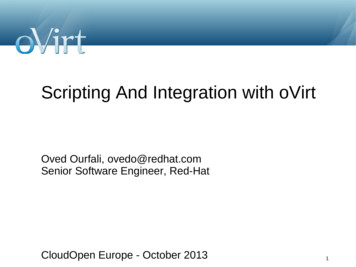4.1* - Ed
:of 4.1.1.1,.r,,.4.1*I%DOCUMENTED 031 194RESUMEJC 690 217By-Holland, John L,; And OthersAn Emprical Occupational Classification Derived from a Theory of Personahty and Intended for Practice andResearch,Amencan Coll, Testing Progrk Iowa City, Iowa, Research and Development Div,Report No- ACT -RR-29Pub Date Apr 69Note- 27p,EDRS Price MF-S0,25 HC- 1,45Descriptors-*Junior Colleges, *Occupational Aspiration, *Occupational Choice, *Occupational Clusters,Occupations, *Vocational CounselingThis report deals with th origin, development, verification, and revision of anoccupational classification. John L. Holland ("The Psychology of Vocational Choice,"1966) proposed an a priori occupational classification of six categories; realistic,intellectual, artistic, social, enterprising, and conventional. These classes were definedin terms of the six Vocational Preference Inventory (VPI) scales having the samenames. Holland calculated a profi!e. of VPI means for 4-year college students withspecified occupational plans. An occupation's coded profile defined an occupation'splace in the classification. In developing this revised classification, 20,313 2-yearcollege students were added to Holland's sample of 4-year college students; datafor some employed adults were also included. In contrast to HoHand's classification,in which the arrangements of subgroups within a maior class had no special meaning,here the maior classes and subclasses were arranged according to a hexsgonalmodel that indicated inter- and intra-class relationships. Student occupationalaspirations were arranged within the model according to their psychologicalrelatedness. The classification has potential applications for vocational guidance,industrial personnel work, and for research in education, psychology, and sociology.(MB)of
NOPAU.S. DEPARTMENT OF HEALTH, EDUCATION & WELFARENo, 29OFFICE OF EDUCATIONTHIS DOCUMENT HAS BEEN REPRODUCED EXACTLY AS RECEIVED FROM THEPERSON OR ORGANIZATION ORIGINATING IT.POINTS OF VIEW OR OPINIONSSTATED DO NOT NECESSARILY REPRESENT OFFICIAL OFFICE OF EDUCATIONApril, 1969POSITIONAN EMPIRICAL OCCUPATIOCLASSIFICATION DERIVED FROMA THEORY OF PERSONALITYAND INTENDED FOR PRACTICEAND ROSEARCHrJAmerican,College Testing Programc;John L. HollandDouglas R. Whitney0.0Nancy S. ColeJames M. Richards, Jr.J:UIPtitr0, Box 168, Iowa City, Iowa52240
SummaryThe origin, development, verification, and revision of anoccupational classification is presented. The classificationorganizes occupations according to their degree of psychological"relatedness" following Holland's theory of personality. Becauseof its theoretical simplicity and empirical base, the classificationhas many potential practical applications for vocational guidance,industrial personnel work, and research in education, psychology,and sociology.tiCALIF.CZLESMAY 2 7 1969CLEARINGHOUSE FORJUNIOR COLLEGEINFORMATION
An Empirical Occupational Classification Derived from a Theoryof Personality and Intended for Practice and ResearchJohn L. Holland, Douglas R. Whitney, Nancy S. ColeJames M. Richards, Jr.2This report presents a revision of the occupational classificationscheme first proposed and tested in an earlier study (Holland, 1966b).The many desirable features of this revised classification enhance itspotential value both for research and for vocational guidance andpersonnel work.The Original ClassificationIn 1959, Holland proposed an a priori occupational classificationof six categories. From 1959 to 1965, this classification was used inseveral theoretical studies, but it was neither directly tested for itsvalue as a classification system nor explicitly defined for clear andeasy use. Later Holland (1966b) defined the major categories of theclassification--Realistic, Intellectual, Artistic, Social, Enterprising,and Conventional--in terms of the six Vocational Preference Inventory(VPI) scales having the same names. The assumption that occupationaltitles in the VPI scales define comparable categories in the classificationmade an explicit reconstruction of the classification possible.To obtain the first empirical version of the classification(Holland, 1966a), a profile of VPI means was calculated for studentsplanning to enter each occupation. An occupation's coded profile(highest scale mean first, next highest scale second, etc. ) definedan occupation's place in the classification. For example, an occupationwith a code of RIES was placed in the major categoryRealistic.The remainder of the code indicated that occupation's particularsubgroup within its major category. The application of this procedureto the VPI data for 12,432 college freshmen in 31 institutions (Abeet al, 1965) produced separate classifications for men and women.The classification for men included all six major VPI categories(Realistic, Intellectual, Artistic, Social, Enterprising, andConventional), each with one or more subgroups. The VPI datafor women yielded only four major groups (Intellectual, Artistic,Social, Conventional) with a number of subgroups within each of themajor categories.This first classification was tested for its usefulness in aseries of studies. In the first study, Holland (1966a) obtainedseveral favorable results: the classification developed from one
sample (N 12,432 college students) produced expected results whenapplied to another sample (N 10,646 college students). When studentswere grouped into six categories according to their occupational choice,their highest mean score occurred on the corresponding VPI scale;that is, students who chose occupations previously classified as"Realistic" had the Realistic scale of the VPI as their highest meanscore. Also, their mean on that scale was higher than the Realisticmean of any other occupational group. Without exception, similarfindings held for the remaining occupational groups of men and women.In a second study, Holland (1968b) demonstrated that individualprofiles using one, two, and three scales could be interpreted accordingto his theory of personality types. For example, Realistic peaks wereassociated with technical competencies and mechanical ability; Intellectual peaks were associated with scientific competencies, mathematicalability, etc. Students with the same high point scale can still bedistinguished by their second highest VPI scale. And students whosefirst two highest scales were the same, can still be distinguishedby their third highest scale. For these three levels of predictivedifficulty, 64-84% of the theoretical predictions of peaks for studentswith different characteristics were correct for large samples of menand women.In a third study, Holland and Whitney (1968) applied theclassification to longitudinal data and obtained unusually efficientpredictions of vocational aspirations over an 8 to 12 month interval.For example, 79% of the men and 93% of the women indicate successivevocational choices that were described as related or lawful ratherthan random. In this later study, a comparison of Holland's (1966a)and Roe's (1956) classification systems suggested that the originalHolland classification appeared to be somewhat more efficient forprediction. (At the same time, Holland's scheme may have enjoyedsome advantages because it was developed from earlier data usingthe same sample of college students. )In an unpublished reanalysis of four-year longitudinal datafrom a national sample of college students (Astin & Panos, 1968), weapplied the classification scheme and obtained closer relationshipsbetween successive vocational choices than had the original authors.In several other unpublished analyses, we again found higherrelationships between successive occupational choices (Sharp &Krasnegor, 1966; Davis, 1965; and others). Generally, thesegains in predictive efficiency were large because most informalclassifications create categories consisting of occupations knownto be psychologically diverse.
-3-Finally, Richards (in Holland, 1968a) performed diagonalfactor analyses to determine whether or not each VPI scale measuresa dimension independent of what the scales have in common. Theresults of separate analyses for large samples (3, 771 men and 3,492women) clearly demonstrate that each scale does measure somethingdifferent from the others; or, there are at least six kinds of people.There may be more, but not fewer.In short, the original classification produces efficientpredictions, contains a set of concepts each with some uniquevariance, and provides explicit interpretations of class membership.The Revised ClassificationThe following is the latest revision of Holland's (1966a)classification. For this revisiot, Vocational Preference Inventory(VPI) data for a large sample of two-year college students (12,345men and 7,968 women) were added to the data obtained in 1966for four-year college students. Data from some samples ofemployed adults were also added to the classification. Theseadditions made the classification more comprehensive andreliable.In this revision, occupations were assigned to classesexactly as before; that is, coded mean VPI scores of all studentsaspiring to an occupation indicated an occupation's place in theclas s ification.In the first classification, the arrangement of subgroupswithin a major class had no special meaning. In the revision,however, the major classes and subclasses were arrangedaccording to the following hexagonal model. (See Figure 1)The hexagonal model was discovered somewhat accidentallywhen we noticed that an intercorrelational matrix for the VPIscales used in the classification could be approximated bythe distances within the hexagon. Subsequent examination ofcorrelation matrices for nine different samples revealed thatthe hexagonal model provided satisfactory approximations.
-4Figure 1: A Hexagonal Model for Interpretating Inter- andIntra-Class Relationships.46REALINTARTCONVENT.54SOC
The Revised Occupational ClassificationIn the following classification note these abbreviations. Underthe heading "sample" "2" indicates two year college students and"4" indicates four year college students and "E" indicates a sampleof employed adults. Underlining indicates "tied codes" or identicalaverage scores on the Vocational Preference Inventory.If two and four year samples were obtained for an occupationthey are placed together. Note that the codes obtained fromdifferent samples are usually similar. The placement ofoccupations with different codes (two year versus four year)was sometimes an ambiguous decision.
REALISTIC CLASS (MEN)Sample422444OccupationArchitectArchitectural l Arts TeacherIndustrial Arts TeacherTrades & Industrial Teacher2DraftsmanRIEA25622Aviation ural & Civil Eng. Tech.Civil EngineeringEl ectrical WorkerElectronic Eng. TechnicianEngineer'Industrial Eng. TechnicianIndustrial EngineerMechanical Eng. TechnicianMechanical EngineerMetal/Machine 85604163246106373981521022AgronomistConstruction WorkerREISREIS16610322Air Conditioning Eng. Technician REICMechanics WorkerREIC552Printer424222242424RESI6124866
INTELLECTUAL CLASS (MEN)Sample44424OccupationAnthropologistPhysical TherapistPhysicianPhysicianBiological ScientistSampleCodeIASRIASR12294ISAE 35422(ISAR) 101ISRA36442444444a424Biologis tISRE55Natural Science Teacher ISREISREPhysical Scientist86Mathematics TeacherHome tDentistDentist55IESR 374IESR 51(IERS) nicianIRASIRAS14IRAS584Engineering ScientistIRAC444BiochemistBiological ScientistBotanistMedical Tec
the same sample of college students. ) In an unpublished reanalysis of four-year. longitudinal data. from a national sample of college students (Astin & Panos, 1968), we. applied the classification scheme and obtained closer relationships between successive vocational choices than had the or
current trends and techniques in the fi eld of analytical chemistry. Written for undergraduate and postgraduate students of chemistry, this revised and updated edition treats each concept and principle systematically to make the subject comprehensible to beginners as well as advanced learners. FEATURES Updated nomenclature Addition of tests for metals based on fl ame atomic emission .
filter True for user-level API (default is False – admin API) persistent_auth True for using API REST sessions (default is False) . UI Plugin API (Demo) Scheduling API VDSM hooks. 51 UI Plugins Command Line Interface . 52 Web Admin user interface Extend oVirt Web Admin user interface. 53 Web Admin user interface. 54 Web Admin user interface . 55 Web Admin user interface. 56 Web Admin user .
ASM Handbook Series on Heat Treating Expands to Four Volumes Springer Science Business Media New York and ASM International 2013 The recently-released Steel Heat Treating Fundamentals and Processes is the first of four upcoming ASM Hand-books on Heat Treating. Under the direction of an editorial team, including Jon Dossett and George Totten as Volume Editors, Volume 4A includes extensive .
ASTM F 891 Cellular Core PVC DWV Pipe ASTM D 2665 PVC DWV Pipe & Fittings NSF Standard 14 Dimensional Standard Schedule 40 Iron Pipe Size (IPS) Cell Class 12454 PVC Solid Wall Pipe & Fittings 11432 PVC DWV Cellular Core Pipe Maximum Working Temperature 140 F Maximum Working Pressure 0 (zero) PSI PVC DWV is NOT a pressure-rated piping system .
Automotive Women Awards 2020 “At Jardine Motors Group, we are extremely passionate about creating an inclusive environment that is accessible to all talent, regardless of their gender, background or ability. This is why we are incredibly proud to continue to support the Automotive 30% Club Inspiring Automotive Women Awards, an amazing initiative that recognises and champions female talent in .
The eginner [s Guide to PEA 3 Introduction Over the last two decades aid agencies and academics have been on a journey of lesson learning and adaptation in relation to politics.
Organizational Behavior 5 Nature of Organization Nature of organization states the motive of the firm. It is the opportunities it provides in the global market. It also defines the employees’ standard; in short, it defines the character of the company by acting as a mirror reflection of the company. We can understand the nature of any firm with its social system, the mutual interest it .
X707/77/02 Biology Section 1 — Questions TUESDAY, 30 APRIL 1:00 PM – 3:30 PM A/SA. page 02 SECTION 1 — 25 marks Attempt ALL questions 1. Primary cell lines have A a limited number of cell divisions and are sourced from tumours B a limited number of cell divisions and are sourced directly from normal animal tissue C an indefinite number of cell divisions and are sourced from tumours D an .























